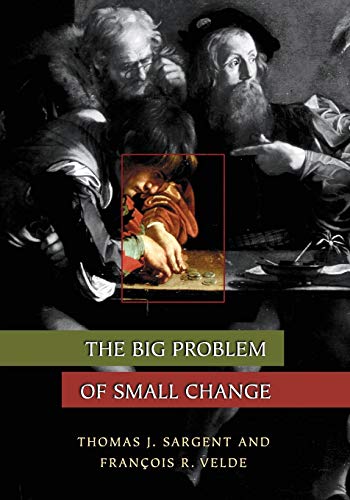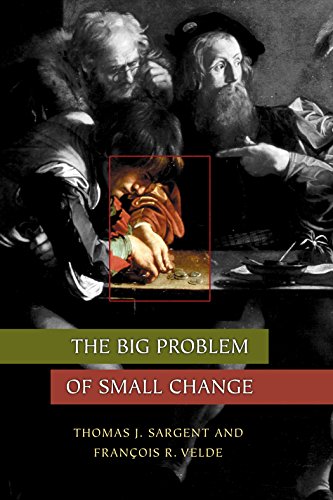Sargent, Thomas J ; Velde, Francois R (15 results)
FeedbackSearch filters
Product Type
- All Product Types
- Books (15)
- Magazines & Periodicals (No further results match this refinement)
- Comics (No further results match this refinement)
- Sheet Music (No further results match this refinement)
- Art, Prints & Posters (No further results match this refinement)
- Photographs (No further results match this refinement)
- Maps (No further results match this refinement)
- Manuscripts & Paper Collectibles (No further results match this refinement)
Condition Learn more
- New (11)
- As New, Fine or Near Fine (3)
- Very Good or Good (1)
- Fair or Poor (No further results match this refinement)
- As Described (No further results match this refinement)
Binding
Collectible Attributes
- First Edition (1)
- Signed (No further results match this refinement)
- Dust Jacket (1)
- Seller-Supplied Images (8)
- Not Print on Demand (14)
Language (1)
Price
- Any Price
- Under US$ 25 (No further results match this refinement)
- US$ 25 to US$ 50
- Over US$ 50
Free Shipping
Seller Location
Seller Rating
-
Big Problem of Small Change
Published by Princeton University Press, 2003
ISBN 10: 0691116350 ISBN 13: 9780691116358
Language: English
Seller: GreatBookPrices, Columbia, MD, U.S.A.
Condition: As New. Unread book in perfect condition.
-
Big Problem of Small Change
Published by Princeton University Press, 2003
ISBN 10: 0691116350 ISBN 13: 9780691116358
Language: English
Seller: GreatBookPrices, Columbia, MD, U.S.A.
Condition: New.
-
The Big Problem of Small Change (The Princeton Economic History of the Western World)
Published by Princeton University Press, 2003
ISBN 10: 0691116350 ISBN 13: 9780691116358
Language: English
Seller: Best Price, Torrance, CA, U.S.A.
Condition: New. SUPER FAST SHIPPING.
-
The Big Problem of Small Change (The Princeton Economic History of the Western World)
Published by Princeton University Press, 2003
ISBN 10: 0691116350 ISBN 13: 9780691116358
Language: English
Seller: California Books, Miami, FL, U.S.A.
Condition: New.
-
The Big Problem of Small Change
Published by Princeton University Press, US, 2003
ISBN 10: 0691116350 ISBN 13: 9780691116358
Language: English
Seller: Rarewaves.com USA, London, LONDO, United Kingdom
US$ 75.69
Convert currencyFree shipping from United Kingdom to U.S.A.Quantity: 1 available
Add to basketPaperback. Condition: New. The Big Problem of Small Change offers the first credible and analytically sound explanation of how a problem that dogged monetary authorities for hundreds of years was finally solved. Two leading economists, Thomas Sargent and Francois Velde, examine the evolution of Western European economies through the lens of one of the classic problems of monetary history--the recurring scarcity and depreciation of small change. Through penetrating and clearly worded analysis, they tell the story of how monetary technologies, doctrines, and practices evolved from 1300 to 1850; of how the "standard formula" was devised to address an age-old dilemma without causing inflation. One big problem had long plagued commodity money (that is, money literally worth its weight in gold): governments were hard-pressed to provide a steady supply of small change because of its high costs of production. The ensuing shortages hampered trade and, paradoxically, resulted in inflation and depreciation of small change.After centuries of technological progress that limited counterfeiting, in the nineteenth century governments replaced the small change in use until then with fiat money (money not literally equal to the value claimed for it)--ensuring a secure flow of small change. But this was not all. By solving this problem, suggest Sargent and Velde, modern European states laid the intellectual and practical basis for the diverse forms of money that make the world go round today. This keenly argued, richly imaginative, and attractively illustrated study presents a comprehensive history and theory of small change. The authors skillfully convey the intuition that underlies their rigorous analysis. All those intrigued by monetary history will recognize this book for the standard that it is.
-
Big Problem of Small Change
Published by Princeton University Press, 2003
ISBN 10: 0691116350 ISBN 13: 9780691116358
Language: English
Seller: GreatBookPricesUK, Woodford Green, United Kingdom
US$ 60.74
Convert currencyUS$ 20.15 shipping from United Kingdom to U.S.A.Quantity: 1 available
Add to basketCondition: As New. Unread book in perfect condition.
-
Big Problem of Small Change
Published by Princeton University Press, 2003
ISBN 10: 0691116350 ISBN 13: 9780691116358
Language: English
Seller: GreatBookPricesUK, Woodford Green, United Kingdom
US$ 71.88
Convert currencyUS$ 20.15 shipping from United Kingdom to U.S.A.Quantity: 1 available
Add to basketCondition: New.
-
The Big Problem of Small Change (Princeton Economic History of the Western World)
Published by Princeton University Press, 2002
ISBN 10: 0691029326 ISBN 13: 9780691029320
Language: English
Seller: ABC Versand e.K., Aarbergen, Germany
US$ 42.81
Convert currencyUS$ 55.06 shipping from Germany to U.S.A.Quantity: 1 available
Add to basketCondition: Gut. 432 S. Kleinere Gebrauchsspuren, innen sauber und ordentlich, Bilbliotheksexemplat mit mehreren Stempl auf dem Buchschnitt und 2 Stempel innen, Reste eines Aufklebers auf dem Buchrücken Q53 Sprache: Englisch Gewicht in Gramm: 1001 Gebundene Ausgabe, Maße: 18.42 cm x 4.45 cm x 26.04 cm.
-
The Big Problem of Small Change (The Princeton Economic History of the Western World, 12)
Published by Princeton University Press, 2003
ISBN 10: 0691116350 ISBN 13: 9780691116358
Language: English
Seller: BennettBooksLtd, San Diego, NV, U.S.A.
paperback. Condition: New. In shrink wrap. Looks like an interesting title!
-
Big Problem of Small Change.
Published by Princeton University Press,, Princeton:, 2002
ISBN 10: 0691029326 ISBN 13: 9780691029320
Language: English
Seller: Grendel Books, ABAA/ILAB, Springfield, MA, U.S.A.
First Edition
Hardcover. Condition: Fine. Dust Jacket Condition: Fine. First printing. Fine in a fine dust jacket. ; 405 pages.
-
The Big Problem of Small Change
Published by Princeton University Press, 2003
ISBN 10: 0691116350 ISBN 13: 9780691116358
Language: English
Seller: Books Puddle, New York, NY, U.S.A.
Condition: New. pp. 434 Index.
-
The Big Problem of Small Change
Published by Princeton University Press, 2003
ISBN 10: 0691116350 ISBN 13: 9780691116358
Language: English
Seller: Majestic Books, Hounslow, United Kingdom
US$ 112.46
Convert currencyUS$ 8.73 shipping from United Kingdom to U.S.A.Quantity: 1 available
Add to basketCondition: New. pp. 434 42 Illus.
-
The Big Problem of Small Change (Princeton Economic History of the Western World)
Seller: Revaluation Books, Exeter, United Kingdom
US$ 90.40
Convert currencyUS$ 33.58 shipping from United Kingdom to U.S.A.Quantity: 2 available
Add to basketPaperback. Condition: Brand New. 432 pages. 10.00x7.00x1.25 inches. In Stock.
-
The Big Problem of Small Change
Published by Princeton University Press, US, 2003
ISBN 10: 0691116350 ISBN 13: 9780691116358
Language: English
Seller: Rarewaves.com UK, London, United Kingdom
US$ 71.89
Convert currencyUS$ 87.31 shipping from United Kingdom to U.S.A.Quantity: 1 available
Add to basketPaperback. Condition: New. The Big Problem of Small Change offers the first credible and analytically sound explanation of how a problem that dogged monetary authorities for hundreds of years was finally solved. Two leading economists, Thomas Sargent and Francois Velde, examine the evolution of Western European economies through the lens of one of the classic problems of monetary history--the recurring scarcity and depreciation of small change. Through penetrating and clearly worded analysis, they tell the story of how monetary technologies, doctrines, and practices evolved from 1300 to 1850; of how the "standard formula" was devised to address an age-old dilemma without causing inflation. One big problem had long plagued commodity money (that is, money literally worth its weight in gold): governments were hard-pressed to provide a steady supply of small change because of its high costs of production. The ensuing shortages hampered trade and, paradoxically, resulted in inflation and depreciation of small change.After centuries of technological progress that limited counterfeiting, in the nineteenth century governments replaced the small change in use until then with fiat money (money not literally equal to the value claimed for it)--ensuring a secure flow of small change. But this was not all. By solving this problem, suggest Sargent and Velde, modern European states laid the intellectual and practical basis for the diverse forms of money that make the world go round today. This keenly argued, richly imaginative, and attractively illustrated study presents a comprehensive history and theory of small change. The authors skillfully convey the intuition that underlies their rigorous analysis. All those intrigued by monetary history will recognize this book for the standard that it is.
-
The Big Problem of Small Change
Published by Princeton University Press, 2003
ISBN 10: 0691116350 ISBN 13: 9780691116358
Language: English
Seller: moluna, Greven, Germany
US$ 68.78
Convert currencyUS$ 57.38 shipping from Germany to U.S.A.Quantity: Over 20 available
Add to basketCondition: New. Dieser Artikel ist ein Print on Demand Artikel und wird nach Ihrer Bestellung fuer Sie gedruckt. Examines the evolution of Western European economies through the lens the recurring scarcity and depreciation of small change. This book tells the story of how monetary technologies, doctrines, and practices evolved from 1300 to 1850 of how the standard f.











